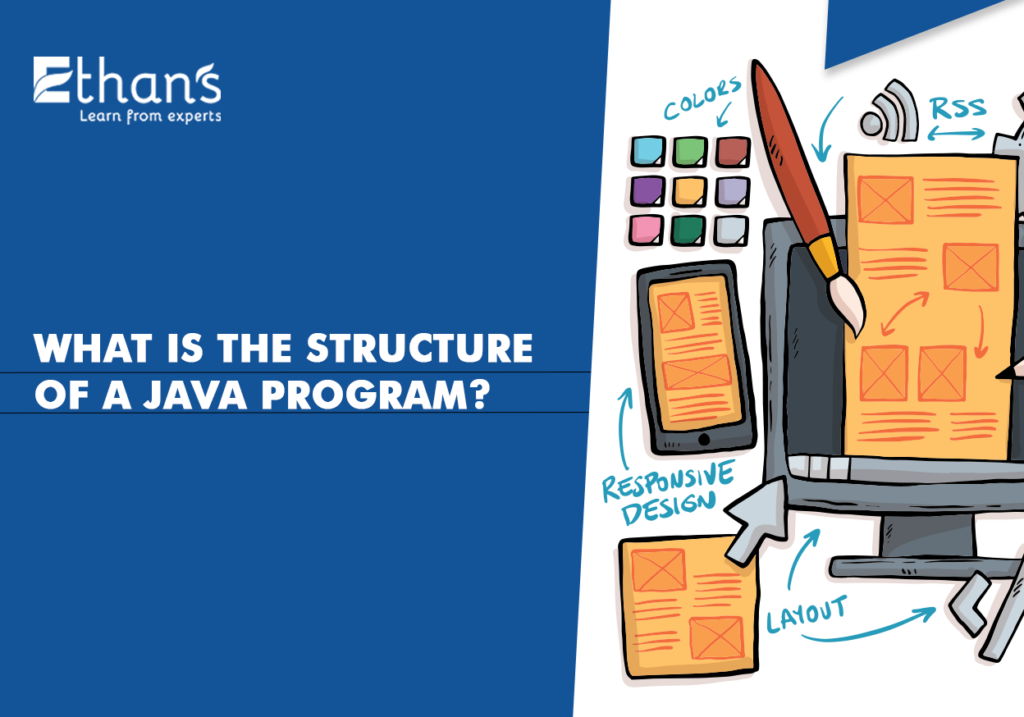Java is an object-oriented programming language famous for its portability, reliability, versatility and security. It is a platform-independent language that enables you to build various types of applications. No wonder, thousands of budding developers prefer learning Java to become a certified Java developer. If you are one, you’ve made the right career choice.
However, before you begin your journey becoming a Java developer, you must understand a few basics to simplify your journey. One of those is the structure of a Java program. Let’s delve more into it.
The Fundamental Structure of a Java Program
A Java program is a collection of classes that group objects with similar characteristics and behaviors. Understanding the structure of a Java program is crucial for problem-solving. It involves identifying the program’s key inputs, outputs and needs. Comprehending these aspects will help you seamlessly develop a solution. The structure of a Java program has various sections. These include Documentation Section, Package Statement, Import Statements, Class Definition, Main Method and the Body of the Class. Here’s more to each.
Documentation Section
Documentation is crucial, yet optional. It provides information about the software’s producer, what the software does, how to use it and its version. As a developer, you typically write the documentation section in a unique comment style – Javadoc. It has comments in /** and */ delimiters. The Javadoc tool processes the text in between the delimiters and converts it into HTML documentation.
A Javadoc comment should be concise and specific and have clear and full words with correct spelling and language. The commenter should ensure consistent formatting and include relevant information about the program or method.
Package Statement
The package line allows you to tell the class what its package is. Packages enable us to place classes into sensible groups. A developer can have separate packages for the interface classes, utility classes, and database classes. The package statement is always the Java program’s first statement. The import statements follow it.
Import Statements
The package has various predefined classes and interfaces. You can import any class from a specific package and use it. The import statement is a representation of the class in the other package. To import the class, you use the import keyword that appears after the package statement and before the class definition. You can import a single class or all in a specific package with the import statement. A Java program allows you to use numerous import statements.
Class Definition
As the name suggests, class definition defines class. Class descriptions have the class name, builders, and variable methods. Class and object have the same name. A developer can use it to refer to the class in other parts of the program.
On the other hand, class variables are declared in the class. Objects in the class share class variables. Further, class methods are class-defined methods that use elements in class to perform the required tasks. Then, you have class constructors that are class-specific builders. You call these builders when they create a class object. Constructors help initialize class objects.
Main Method
It is the starting point of Java programs that initially search for. You write the main method in a specific way to enable the computer to understand it – “public static void main(String[] args)”.
Here, static means the main method doesn’t belong to a particular part of the program. Void indicates that the main method doesn’t give you anything exclusive when you do it. The main method takes an array of strings called args – an acronym for arguments. These arguments are little notes you provide to the main method when you begin the program. These notes instruct the main method what to do or provide it with some unique information.
Body of the Class
This is where the code for the class is. You can use builders, methods, and variables to break up the code in the body of the class. Methods are the elements that the objects of a class can do. Constructors are the methods in a class that you can use to make new things. Variables are the data that the class’s objects store. You write the body of the class between the curly brackets “{body}”. These braces signify the beginning and end of the body of the class.
In addition to these, a Java program structure also has data members and various types of methods. So, let’s overview them.
Data Member Types in a Java Program Structure
A Java program structure has two data member types – instance data member and static data member. Here’s more to both.
Instance Data Member
- Regardless of the number of objects you produce, the system always allocates memory when you form an object.
- It has common values in a class variable
- The keyword static always follows the declaration of a class-type variable
Static Data Member
- Memory gets allocated only once when a class gets loaded into the main memory.
- An example variable stores specific values.
- You shouldn’t declare an instance variable before using the keyword static.
Methods Types in a Java Program Structure
There are two types of methods in a Java program structure – instance method and static method.
-
Instance Method
Instance methods help conduct repetitive activities like reading records from files. You can begin method declaration without a static keyword. Furthermore, you should use the relevant object name to access every instance method. The results aren’t shared. Every object has a distinct instance method copy.
-
Static Method
These methods help perform a single operation like opening files or setting up a DBMS connection. The method definition should have the static keyword. You must access every static method with its corresponding Class name. Same class objects will always share the static method results.
Wrapping Up!
We hope the above gave you enough insights into the structure of a Java program. You must have found a lot of the above information technically. Understanding it and learning more about Java program structure requires joining comprehensive Java classes in Pune. If you want to do that, enroll in Ethans. We will help you build a robust foundation for a promising career in Java. Call us at +91 95133 92223 to explore Java courses in Pune, fees, etc.




